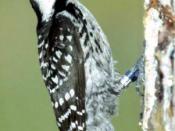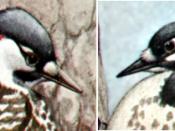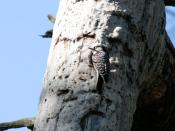- -
MANAGEMENT TECHNIQUES FOR THE
RED-COCKADED WOODPECKER ON FEDERAL LANDS
Sean Fraser
NRM 304
ABSTRACT
The red-cockaded woodpecker (Picoides borealis) has been listed as an endangered species since October, 1970. This species inhabits pine forests in the southeastern United States where the majority of prime timberland is privately owned. Private ownership of preferred habitat and historically destructive silvicultural practices create unique problems for federal wildlife managers. This report analyzes three management techniques being used to assess and augment red-cockaded woodpecker populations on federal lands in the region, primarily military installations. Seeking cooperation between diverse government agencies, wildlife managers attempt to accurately assess species abundance, alter woodpecker nesting cavities, and construct nest sites in an effort to enhance red-cockaded woodpecker habitat on limited federal holdings in the American southeast.
Key words: Picoides borealis, Global Positioning System, Geographic Information System, cavity trees, cavity restrictors
The red-cockaded woodpecker (Picoides borealis) is an endangered species that inhabits pine forests in an historical range from Texas to the Atlantic coast (Jackson, 1986; Reed et al.,
1988). Picoides borealis nest in clans or family groups that usually consist of one breeding pair and 2 non-breeding male helpers (Jackson, 1986 ). This group establishes and defends a territory that includes foraging habitat and nesting 'cavity trees' (Copeyon et al., 1991; Jackson et al., 1986; Rossell and Gorsira, 1996). Red-cockaded woodpecker clans excavate cavities in living pines, and have established a living and foraging routine in conjunction with the southeastern pine forests and the historical occurrence of fire, which reduces hardwood understory while sparing fire-resistant pines (Jackson, 1986). Much of the prime nesting and foraging habitat for this species has been systematically eliminated due to development, timber harvest and intensive fire suppression (Jackson, 1986). The emergence of dense hardwood understory and midstory as a result of fire...


